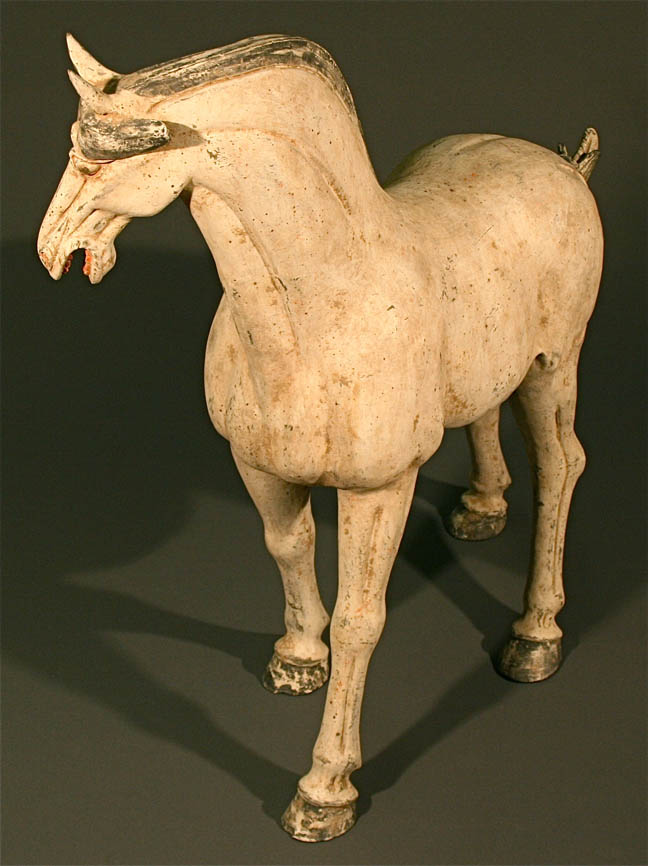

Title: Large antique Chinese artifact terra cotta pottery horse
Shipping: $200.00
Artist: N/A
Period: 7th Century
History: N/A
Origin: N/A
Condition: Excellent
Item Date: 618 AD to 907 AD
Item ID: 3282
Beautiful terra cotta horse from approximately the Tang Dynasty. This handsome pottery piece is an incredible example of the era. This is a large, dominant piece with exquisite detail. It is muscular, handsome and strong. This is a unearthed fragments of a large sized Terra Cotta horse. Excavations of vaults reveals these great old terracotta animals. This is a antique original terracotta decorative accessorie. Papers can not be found by owner. Today, the market of Chinese art is widely reported to be among the hottest and fastest-growing in the world, attracting buyers all over the world. The Voice of America reported in 2006 that Chinese art is raking in record prices both internationally and in domestic markets. Sotheby's noted that Chinese art has rapidly changed the Asian art world into one of the most dynamic sectors on the international art market.
Link: http://en.wikipedia.org/wiki/Tang_Dynasty
The Tang Dynasty (Chinese: 唐朝; pinyin: Táng Cháo; IPA: [tʰɑ̌ŋ tʂʰɑ̌ʊ̯]; Middle Chinese: dhɑng) (June 18, 618–June 4, 907) was an imperial dynasty of China preceded by the Sui Dynasty and followed by the Five Dynasties and Ten Kingdoms Period. It was founded by the Li (李) family, who seized power during the decline and collapse of the Sui Empire. The dynasty was interrupted briefly by the Second Zhou Dynasty (October 16, 690–March 3, 705) when Empress Wu Zetian seized the throne, becoming the first and only Chinese empress regnant, ruling in her own right.
Chinese art (Chinese: has varied throughout its ancient history, divided into periods by the ruling dynasties of China and changing technology. Different forms of art have been influenced by great philosophers, teachers, religious figures and even political leaders. Chinese art encompasses fine arts and folk arts. Early forms of art in China were made from pottery and jade in the Neolithic period, to which was added bronze in the Shang Dynasty. The Shang are most remembered for their blue casting, noted for its clarity of detail.In early imperial China, porcelain was introduced and was refined to the point that in English the word china has become synonymous with high-quality porcelain. Around the 1st century AD, Buddhism arrived in China, though it did not become popular until the 4th century. At this point, Chinese Buddhist art began to flourish, a process which continued through the 20th century. It was during the period of Imperial China that calligraphy and painting became highly appreciated arts in court circles, with a great deal of work done on silk until well after the invention of paper. Buddhist architecture and sculpture thrived in the Sui and Tang dynasty. Of which, the Tang Dynasty was particularly open to foreign influence. Buddhist sculpture returned to a classical form, inspired by Indian art of the Gupta period. Towards the late Tang dynasty, all foreign religions were outlawed to support Taoism. In the Song dynasty, paintings of more subtle expression of landscapes appeared, with blurred outlines and mountain contours which conveyed distance through an impressionistic treatment of natural phenomena. It was during this period that in painting, emphasis was placed on spiritual rather than emotional elements, as in the previous period. In the Yuan dynasty, painting by the Chinese painter Zhao Mengfu (趙孟頫) greatly influenced later Chinese landscape painting. Under efforts of masters from the Shanghai School during the late Qing Dynasty, traditional Chinese art reached another climax and continued to the present in forms of the "Chinese painting" (guohua, 國畫). The Shanghai School challenged and broke the literati tradition of Chinese art, while also paying technical homage to the ancient masters and improving on existing traditional techniques.